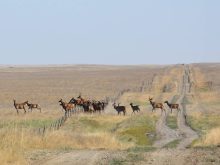Farmers deciding when to spray this spring should watch weed stages rather than the calendar.
Warm, dry conditions in late March and early April allowed many grain producers to get a head start on seeding.
Farmers in Manitoba and parts of southern Alberta were able to complete up to 50 percent of their planting before the third week of April.
Higher than average soil temperatures helped germination and timely rain hastened crop development.
But these conditions have left weed stages out of step with the early crop.
Read Also

New program aims to support plant-based exports to Asia
Understanding the preferences of consumers in Taiwan and how they differ from Indonesia or Malaysia isn’t easy for a small company in Saskatchewan.
“Green foxtail is one weed that will be delayed by recent cool weather and the crop can get a bit of an advantage,” said Neil Harker of Agriculture Canada.
“Wild oats and quackgrass on the other hand are enjoying the early start and the cooler weather.”
Todd Andrews of Manitoba’s agriculture department agreed.
“In the Red River Valley, producers were seeding deeper, into moisture. It was still dry on top and weeds didn’t get the early start that the crop did.”
This resulted in strong crop establishment with few germinated weeds.
Andrews said growers may be able to skip spraying if the crop has advanced well enough.
“It all depends on what the weeds are doing relative to the crop. You can’t count on weeds growing taller, though. You have to check the number of leaves to know the stages and try to assess whether they will hurt yields.”
Rick Holm, of the plant sciences department at the University of Saskatchewan, said producers may be inclined to wait for later flushes of weeds. However, he said research has shown that the earliest weeds compete more vigorously with crops.
The sooner they are eliminated, the better the crop will later compete and yield.
“(Farmers) may want to get in there and spray as soon as their crop reaches the right stage. Waiting for another bunch of weeds may not be much of an advantage.”
But spraying must be timed to avoid frost. Frost has hit much of the Prairies and agrologists warn that the cold nights may continue for some time.
“Farmers have to be prepared to wait for the crop and the weeds to bounce back from the frost.
“You need at least four days of warm weather before you can count on your herbicide to do its job,” Andrews said.
Metabolism can be affected while plants recover from frost and may not be fully absorbed by the weed, limiting the application’s effectiveness.
Frost-damaged crops should show new, normal plant growth before herbicide is applied.
Holm suggests that “if frost is in the forecast, farmers should consider waiting with spraying,” because the crop may be weakened by the herbicide and suffer a more serious blow by the frost.
“It’s early and temperatures can drop really quickly. We shouldn’t be deceived by early warm weather,” Harker said.
“Weather and temperature can play a big factor with some sprays. Odyssey for instance, when sprayed on peas, can injure the crop if the temperature is cool.”
Other herbicides such as Achieve can also damage plants under cool conditions.
Herbicides are designed to break down in normal growing conditions but in cool weather they linger in the tissues of less active plants and begin to do damage.
















